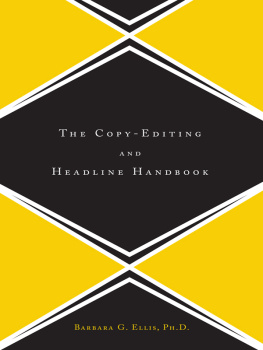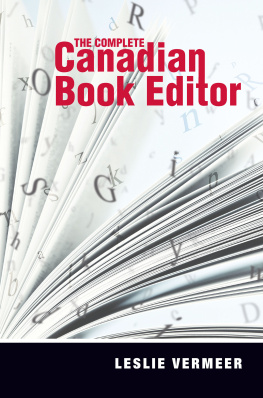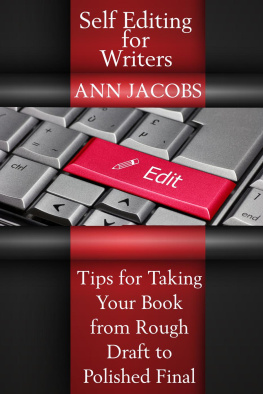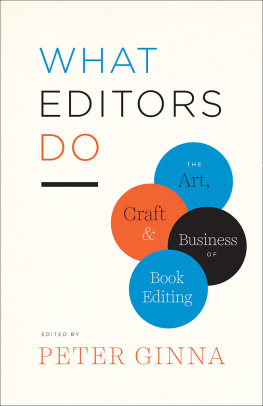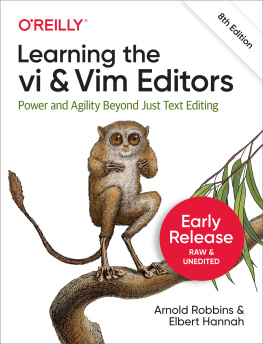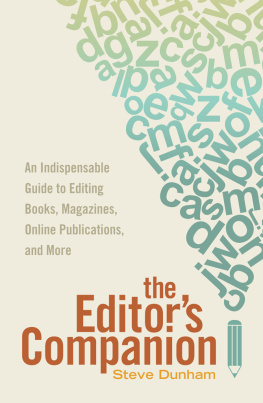Editors on Editing
Editors on Editing
What Writers Need to Know About What Editors Do
Completely Revised Third Edition


Copyright 1962, 1985, 1993 by Gerald Gross
All rights reserved. No part of this book may be reproduced in any form or by any electronic or mechanical means, including information storage and retrieval systems, without permission in writing from the publisher, except by a reviewer, who may quote brief passages in a review. Scanning, uploading, and electronic distribution of this book or the facilitation of such without the permission of the publisher is prohibited. Please purchase only authorized electronic editions, and do not participate in or encourage electronic piracy of copyrighted materials. Your support of the authors rights is appreciated. Any member of educational institutions wishing to photocopy part or all of the work for classroom use, or anthology, should send inquiries to Grove/Atlantic, Inc., 841 Broadway, New York, NY 10003 or permissions@groveatlantic.com.
Published simultaneously in Canada
Printed in the United States of America
Due to limitations of space, copyright acknowledgments appear on page 379, which serves as an extension of this copyright page.
Library of Congress Cataloging-in-Publication Data
Editors on editing : What writers need to know about what
editors do /
[edited by] Gerald Gross.3rd ed.
p. cm.
Includes bibliographical references.
eBook ISBN-13: 978-0-8021-9468-8 (pbk.)
1. Editing. 2. EditorsCorrespondence. I. Gross, Gerald.
PN162.E36 1993
80827dc20 92-29806
Designed by Deidre Amthor
Grove Press
an imprint of Grove/Atlantic, Inc.
841 Broadway
New York, NY 10003
Distributed by Publishers Group West
www.groveatlantic.com
To unsung editors everywhere,
past, present and future:
May these pages sing your praises
To published and unpublished
writers everywhere:
May these pages guide you
to a better understanding of the art
and craft of the editor
Acknowledgments
My thanks and deep appreciation to all the editors who stole precious time from their crowded days and nights and gave so generously of their talents by contributing such splendid original essays to Editors on Editing. Editing editors is a high-wire-without-a-net exercise in delicacy and diplomacy; therefore, I also want to thank the contributors for responding with such grace under pressure to my editorial suggestions.
For their advice, counsel, and recommendations of editors to invite to contribute to the book, I want to thank (in alphabetical order) Carole Abel, Richard Curtis, Anita Diamant, Mitch Douglas, Joyce Engelson, Herman Gollob, Bert Holtje, Gerald Howard, Evan Marshall, Ruth Nathan, Ms. Bobbe Siegel, Ted Solotaroff, Bill Thompson, and Tom Wallace.
(My apologies to anyone Ive forgotten to mention, but be assured that my heart remembers everyone who helpedeven if my memory does not.)
For sharing my vision for Editors on Editing and making important contributions to the focusing and realization of that vision, I thank my dedicated and creative editor, Bryan Oettel.
For his intelligent, perceptive, sensitive, and, yes, even affectionate copy editing, I thank my copy editor, Ed Sedarbaum. His skill has orchestrated this anthology of thirty-nine different voices into a mellifluous chorus of clarity and coherence.
Finally, I thank my best friend and beloved wife, Arlene, for the support and encouragement she has given me in this and each of my other endeavors for over thirty-six years.
Preface: Reflections on a Lifetime of Editing
Thirty years have passed since Editors on Editing was first published in 1962and seven years have gone by since it was revised in 1985. The book you now hold in your hand is far more than a revision of those two editions of Editors on Editing, retaining as it does only one piece from the previous edition of the work. It contains thirty-two original essays especially commissioned for this volume, plus five essays on editing and publishing that did not appear in previous editions. This is a completely new edition of what has become the standard work on the art and craft of editing in our country, used in publishing courses, writing courses, and writers conferences throughout the United States.
Because I give workshops and lecture widely at these writers conferences, and know how eager writers are to have a happy, effective, creative relationship with an editor, I wanted to focus this new edition of Editors on Editing on what a writer needs to know about what editors do. Many writers suffer from a myriad of misconceptions about what editors will or wont do with and to their manuscript; they are unsure of the ways in which an editor can help them improve their manuscript; they are unclear as to the dynamics of the editor-author relationship: what each can and should expect from the other in the editing process; they are anxious and unsure about their rights to their own manuscript once it is accepted by an editor. Many writers are not aware of what developmental, line, and copy editors do and how they do it. Finally, they often dont know how and why some manuscripts are accepted and others rejected. The list of myths and erroneous assumptions goes on and on and on. To clarify the many creative, technical, and empowering ways in which an editor works with a writer, I wanted this edition of Editors on Editing to demystify for the writerpublished and unpublishedthat mysterious process known as editing. And I also wanted to reveal the editor as a passionately committed, caring professional who loves writers and who is dedicated to helping the writer say what the writer wants to say in the most effective way, one that will reach the widest possible audience.
To that end, as I did in compiling the first two editions of Editors on Editing, I went directly to the industrys top editors, the men and women who know their art and craft best and also know how to communicate their excitement and their expertise. Included among them are Ruth Cavin on Editing Crime Fiction; Charles Spicer on Editing True Crime; Maron Waxman on Line Editing: Drawing Out the Best Book Possible; Mel Parker on The Pleasures and Perils of Editing Mass-Market Paperbacks; and Scott Walker on Editing for a Small Press: Publishing the Way It Used to Be.
These top professionals write with insight and candor about the special demands and skills necessary to their particular areas of editorial expertise. To make their comments as prescriptive, as practical as possible for both the beginning and experienced writer, I asked them to focus their essays on specific examples of the variety of ways an editor actually edits: everything from suggestions for a new beginning or a new ending to ideas for bringing a character to life, or smoothing out a difficult narrative passage, or clarifying a flashback or a flash-forward or dream scene, or a way to accelerate the pace and plotting of the story, and so forth.
Accordingly, the thirty-eight essays in this volume offer the writer solutions to the problems posed by the manuscript, guiding the writer through the various stages of publication from the inception of the idea through developmental editing, line editing, and copy editing to publication and afterwards. The result is, I hope, an informative short course in the editorial side of publishing that should make a writer feel confident, knowledgeable, and effective at any stage of his or her relationship with an editor.
Next page

